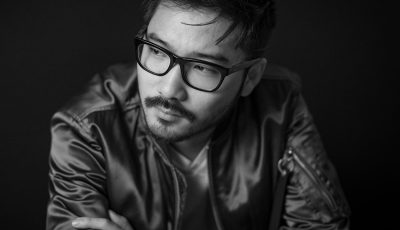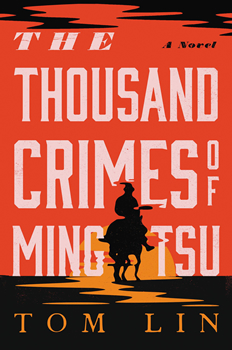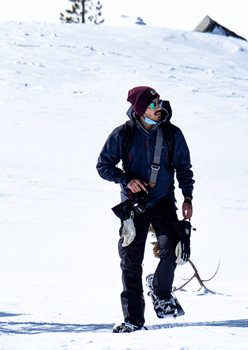

On the Cover: Tom Lin
A Western—Except the Protagonist is Chinese American
If you’re looking for Tom Lin’s debut novel on the shelves of your local bookstore, you might find it under Crime Fiction or just as easily under Western Fiction.
Set in the 1860s, as the railroad was connecting east to west, THE THOUSAND CRIMES OF MING TSU introduces us to the mysterious and lethal assassin Ming Tsu, who roams the West seeking vengeance against the railroad barons and racist lawmen who’ve exploited him and his fellow Chinese workers, while making his way back to his wife Ada, the daughter of a powerful railroad magnate. Along the way, he meets up with a blind clairvoyant known as the prophet and a troupe of magic-show performers, some of whom exhibit supernatural powers. Mayhem ensues.
Lin, 25, lives in Davis, California, with his girlfriend, Pia, and their cat Breezy, while he is enrolled in the PhD program at the University of California, Davis. In this exclusive The Big Thrill interview, he shares insight into his writing journey and what inspired his powerful debut.
Tell us a little about your background.
I was born in Beijing, China, but I grew up an only child in Flushing, New York. My family had immigrated to Sydney, Australia when I was two, so we arrived in New York when I was four years old. When we first left China, my mother was a pharmaceutical sales rep for Alcon, and my dad was an early-career orthopedic surgeon. They emigrated to pursue further opportunities beyond China. These days, my mother’s a nurse in New York City, where she lives with Argo, her elderly and overweight Siberian husky, and her parents, my grandparents. My father returned to Beijing around 2002, during the SARS pandemic—talk about eternal return—where he now lives and works, still as an orthopedic surgeon. I usually see him a few times a year—not once this past year, of course, but ordinarily—and my mother and I usually manage to get to China once or twice a year to see family.
What were you like as a kid?
I think the most accurate description of me as a child is that I was 听话 tīng huà—literally “listening to words” but closer to “well-behaved” or “heedful.” I was studious because my parents taught me to value my education, and I was quiet when shushed. I was about as athletic then as I am now, which is to say that I was not athletic in the slightest. I was an ungainly kid, excitable and eager to please. I hated getting in trouble. Of course, as I entered my horrifically awkward teenage years, I became less and less 听话 tīng huà (“heedful”), often getting into full-throated shouting matches with my dear mother, who didn’t deserve any of that.
How about your schooling?
I went to Pomona College in southern California, ostensibly an hour from most of what Los Angeles has to offer. It once took me three hours on the freeway to get back to Pomona from what was meant to be a quick jaunt to LACMA. Hence “ostensibly.” I studied English at Pomona and loved every minute of it. I wanted to be a novelist—I’d wanted that since I was a kid—but as I grew up and learned how much of a long shot that was, I resolved to study literature as a critic, which seemed to me a more pragmatic major with skills that were more readily transferrable to what I’d been told was an ever-grimmer job market. After I graduated, I decided to pursue a PhD in English. My research interests are in the relations and tensions between the imagined worlds of science fiction and the interdisciplinary field of science and technology studies. The ultimate dream is to write novels and teach English at an undergraduate level. I’m told quite often that the job market is anemic at best and moribund at worst; pessimism of the intellect, optimism of the will, as Gramsci says.
What was it like as an Asian kid growing up in Queens, NY?
I was lucky to have grown up in Flushing, one of the most ethnically and linguistically diverse communities on the planet, according to the Guinness Book of World Records. My family shopped for groceries at the local Asian grocers—there were only a handful nearby when I was a child—and by the time I was a teenager we were spoiled for choice. I attended public school until seventh grade, when I transferred to Trinity High School, a private school in Manhattan that was celebrating their 300-year anniversary the year I showed up. I was there because I was exceptionally fortunate—I am an alumnus of Prep for Prep, a NYC-based leadership development educational nonprofit that selects cohorts (“contingents” in Prep parlance) of high-achieving New York children of color to attend a two-year series of after-school and summer programs in preparation for entry into the city’s elite private schools. When I graduated from Trinity, I was one of maybe a dozen Asian students in my grade and one of only two Asian boys. I wasn’t teased much—I like to think I was quite well-liked—and I can’t recall ever experiencing an overt incident of racism, either. But something I’d bet is common to both my experiences of growing up Asian in America is the constant, unshakeable awareness that you are different, perpetually and irreconcilably Other. In my writing I try to body forth this awareness and bring it onto the page in a form that cuts close to the body. I want to reproduce this awareness of alterity as a set of visceral sensations—to recreate in readers that feeling, in some attenuated form, of distant difference: the feeling of being strange and unfamiliar even at home.
When did you first start writing?
I started writing as soon as I knew how. As a child I filled notebook after notebook with hundreds of pages of utterly incoherent pastiche, most strongly influenced by whatever I had read most recently. I wrote short stories, too, but I was never any good at them. I began to take my writing seriously when I was in high school. Before THE THOUSAND CRIMES OF MING TSU, I had written two long-form manuscripts: the first was an extravagant mess, some 60,000 words long, and the second was a novella, 30,000 words. My writing was at such a novice level that I could feel myself growing more confident and more clear over the course of writing the manuscript, with the result that (and this is true of both “drawer manuscripts”) the endings were far better than the beginnings and the middles. I was learning by doing, but this is only apparent in retrospect. I would like to burn them.
What writers have influenced you?
John Steinbeck, for his ability to capture not simply the historical facts of a place and time (California in the early 20th century, specifically) but also the real visceral feeling of being alive there and then. East of Eden is my favorite of his. And Jorge Luis Borges, whose short fictions have always captivated and entranced me. I particularly love “Funes the Memorious,” “The Garden of Forking Paths,” and “Pierre Menard, Author of the Quixote.” Jose Saramago—his books Blindness and Death with Interruptions especially—for their deceptively labyrinthine cadence and their clarity of feeling. László Krasznahorkai’s Satantango and his unsettling two-for-one book Herman/The Last Wolf. His work has always inspired in me a mix of dread horror and awe, akin to seeing the vast shape of a whale passing slowly beneath you as you tread water at sea. And Herman Melville’s Moby-Dick, on which I wrote my undergraduate thesis, and which is among my favorite books.
What’s your writing routine?
I’m the furthest thing from disciplined. I’ve always found writing to be an utterly withering ordeal—it exhausts me absolutely. I wish I had the discipline of those superheavyweight authors who daily rise with the sun and crank out four hours of writing before their ten-mile run or what have you. My writing routine more closely resembles trench warfare: interminable boredom punctuated by moments of extreme terror. I do outline, but my outlines are useful to me alone, and even then just barely—a clutch of unordered Post-Its, single-page printouts of passages, notebooks full of illegible diagrams. Often the actual writing happens in brief and intense bursts, during which times I sometimes forget to eat three square meals a day and notch eight (or any) hours of sleep. It’s a genuine miracle that I manage to produce anything at all.
Tell us about the genesis of THE THOUSAND CRIMES OF MING TSU.
The idea for the book came to me as a one-line pitch, intense and inchoate: “a Western, except the protagonist is Chinese American.” It was like being struck by a bolt of ambiguous lightning. I couldn’t shake it. I was in California, heady with the freedom of being an unsupervised adolescent who had recently gotten a car of his own—huge for a kid from New York City who had always taken the subway—and I felt compelled to put into words the feeling of cutting out across the desert, of being made insignificant by a magnificent landscape. I was also trying to articulate, for myself, what it meant to be Chinese American—what it meant for me to be Chinese American. These two desires merged into this originating phrase, “a Western, except the protagonist is Chinese American.”
The more I worked on it, the more I found the idea expanding and solidifying—there was, for instance, the except in “except the protagonist is Chinese American,” a conjunction that revealed the expectations of Whiteness that permeate our ideas of what a Western is and isn’t. Ming Tsu is my answer to that received, mythic Western: a Chinese American protagonist whose actions and motivations stay front and center throughout, never relegated to an ancillary role, as often happens to Chinese American characters in Westerns. The cast of the magic show, meanwhile, is my way of thinking through how spectacle and entertainment can work to neutralize the threat that difference poses to existing structures of power—but enough from the critic in me!
What is the roll of what you call “real magic” in your novel?
I want to distinguish between magical realism and what, I think, is at work in THE THOUSAND CRIMES OF MING TSU, which I’ve taken to calling “real magic.” I think the term “magical realism” describes a set of literary traditions operating within a characteristic mode; specifically, I think the term refers to the works of Latin American writers as they engaged with questions of modernity and structural power in their specific cultural contexts. My term ‘real magic’ is in some ways an attempt to maintain the specificity of ‘magical realism,’ though I think the two terms have a lot in common. Ultimately, all these terms—realism, magical realism, fantasy, and “real magic”—name different approaches to the problem of destabilizing the here and now, the experience of being alive as it happens to you, one second per second.
Magical realism, by imagining a world in which even the fantastical becomes ordinary, calls into question the ordinariness of our own real lives, asking us to rediscover magics that have long ago become banal for us. I wanted the real magic in THE THOUSAND CRIMES OF MING TSU to trouble and defamiliarize—to slow down the experience of the present, and by doing so make room for anything, even magic, to arise. I think that this sense of a wild and uncertain future, full of total possibility, lies right at the heart of our Western imagination. And nothing says “total possibility” like a shapeshifter, a telepath, and a fireproof woman.
You also don’t use extensive flashbacks to inform the reader in terms of Ming’s past—you just hint at it or deal with it briefly in passing. Why did you make that choice?
One of the questions the book grapples with is the nature and function of memory. What kind of a thing is a memory? What is the effect of memory on the world and on us as individuals? My memory has never been excellent, beyond an odd knack for retaining the kind of broadly useless knowledge that might come up in pub trivia. I wanted to reproduce the feeling of uncertain memory in the text, while also accounting for the materiality of the medium—if it’s written in the book, you can always flip back to it and jog your memory even when the characters begin to forget. I wanted readers to feel as uncertain about Ming’s past as Ming himself, to grow suspicious and apprehensive of memory as Ming himself. So I use memories that come in hazy flashes, leaving between them large gaps in time and space that can only be bridged by the imagination, not by memory. The idea was not to recreate memory loss but rather to explore the fluid and ambiguous stuff of memories.
What’s next?
I’m beginning to gather notes and research for a new novel. I think it’ll be quite different from this one. In any case, I’m excited to see where it goes.
- Tom Baragwanath - February 22, 2024
- Jess Lourey - September 21, 2023
- Reed Farrel Coleman - July 7, 2023






